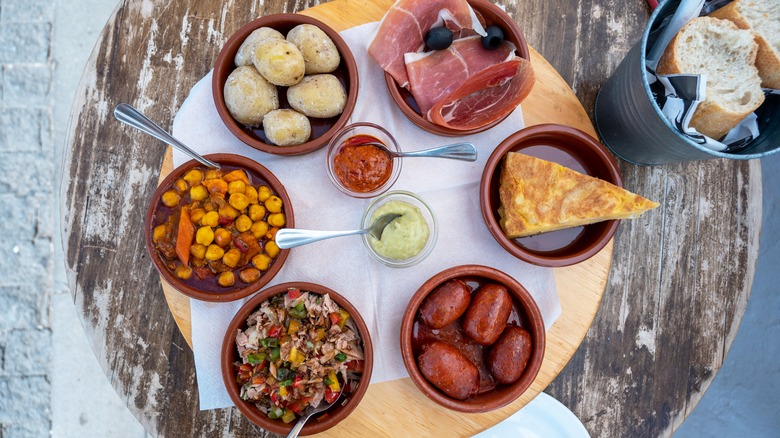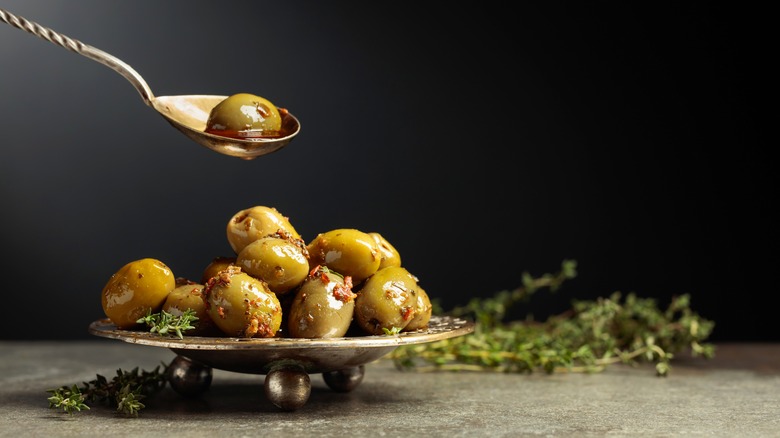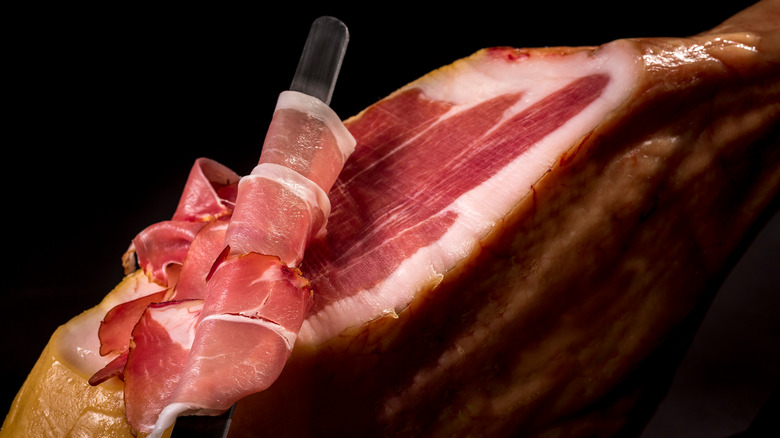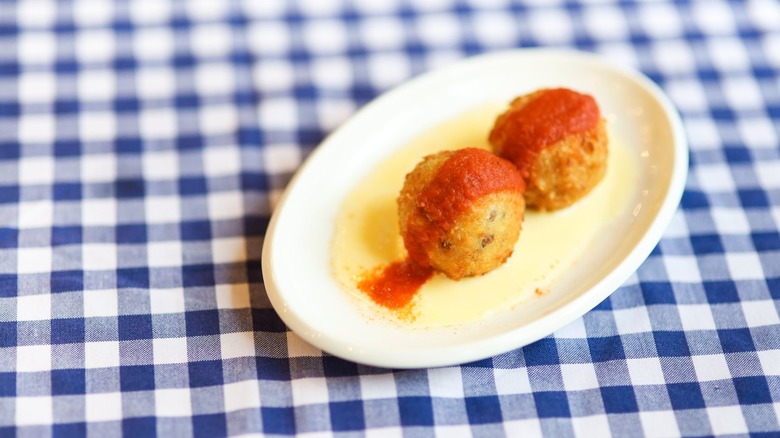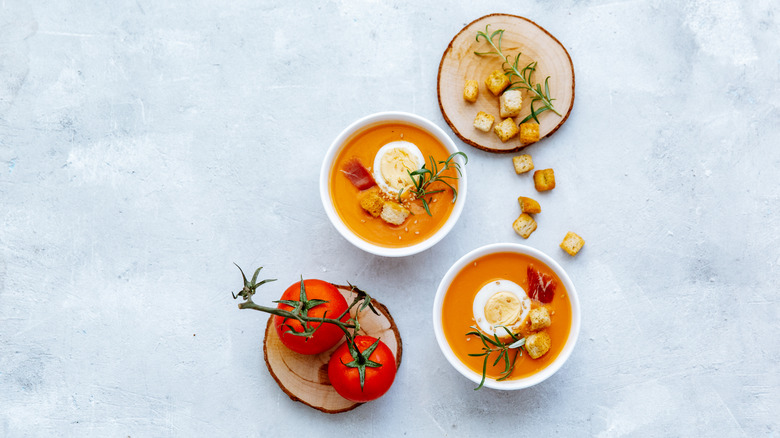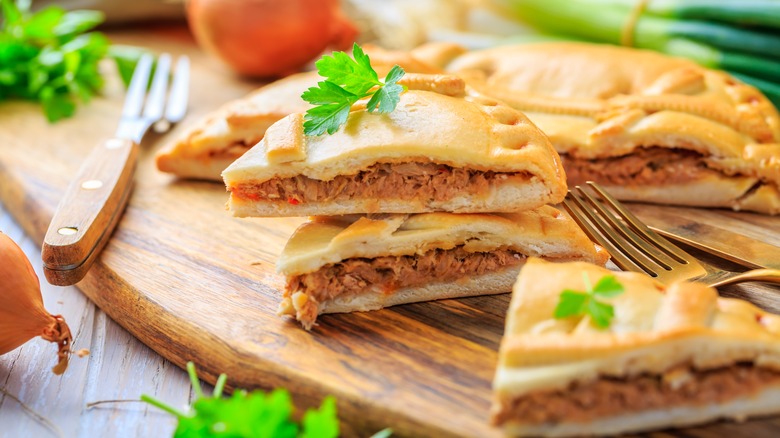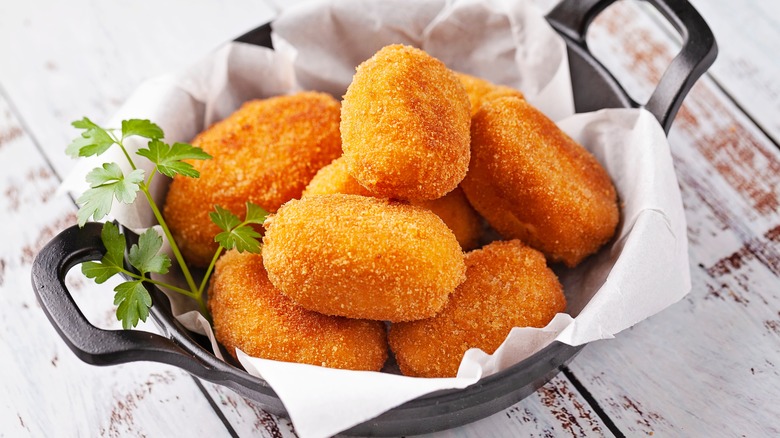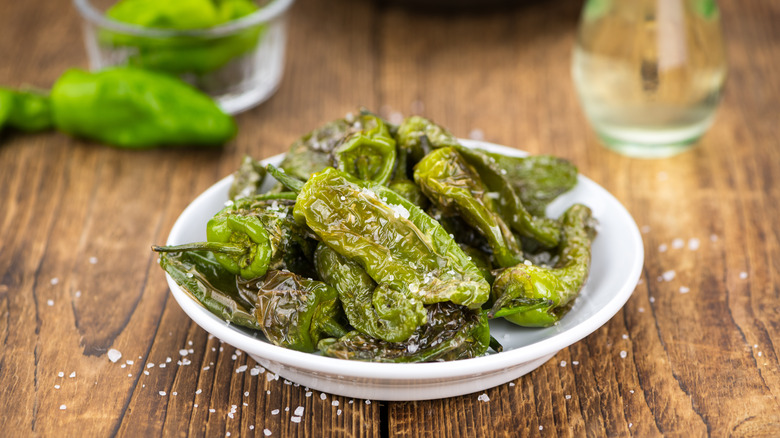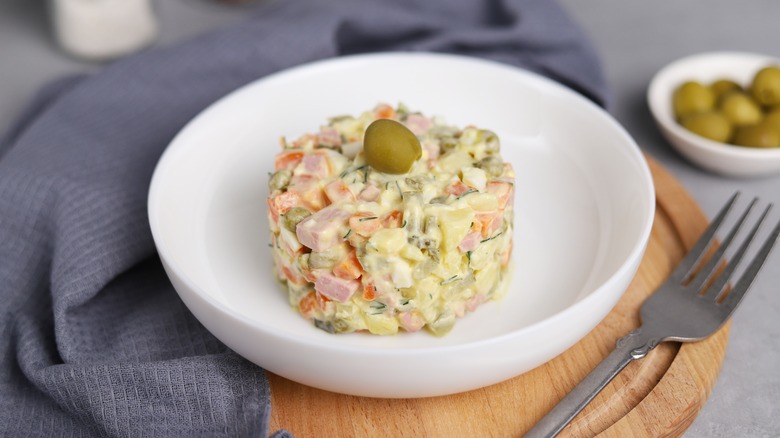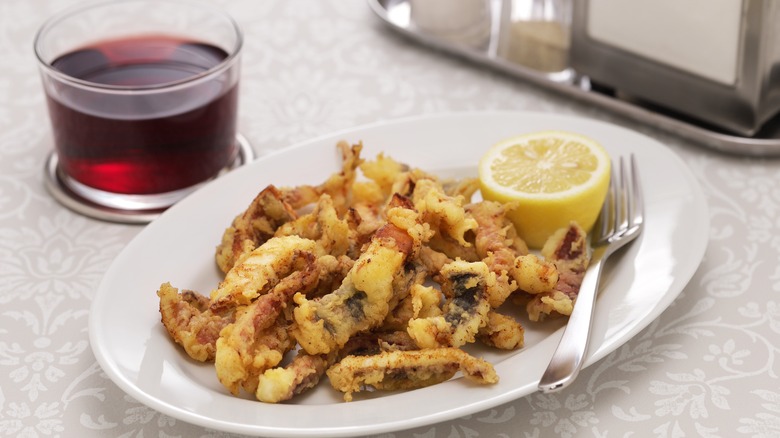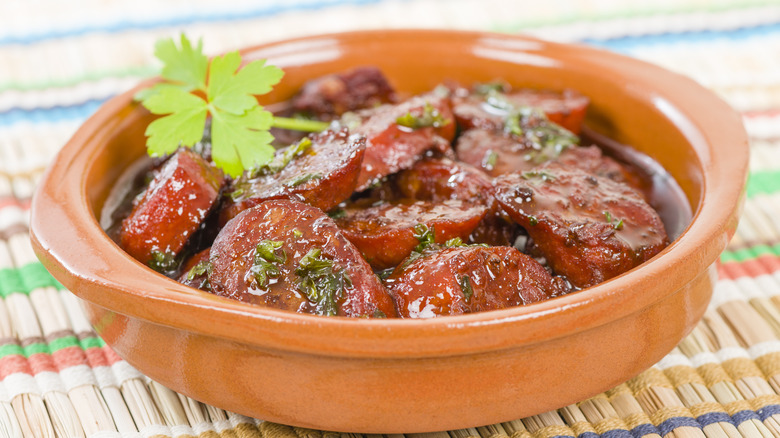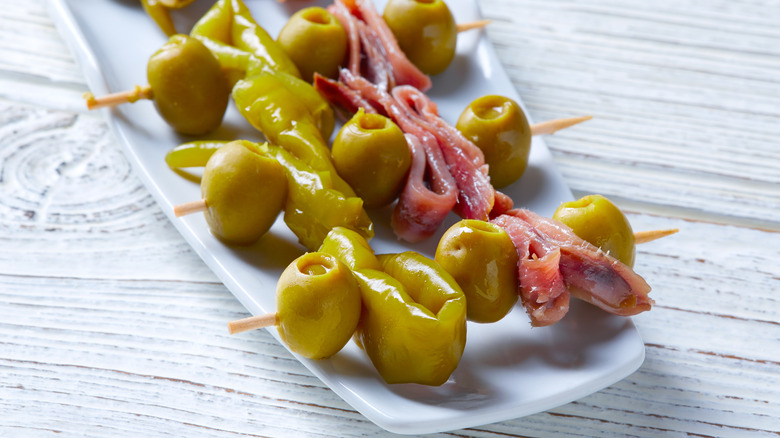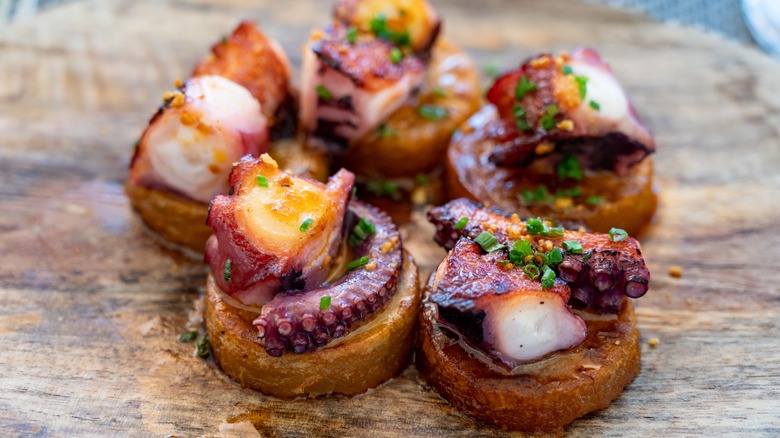29 Traditional Spanish Tapas Dishes, Explained
Spain is known for a good many things: Flamenco dancing, siestas, bullfighting, and enjoying historically late dinners, to name a few. But if there is one prominent aspect of the Spanish lifestyle, it's probably the tapa. Citylife Madrid calls tapas an integral part of Spanish culture, although it admits the origin story is murky. One story tells of how tapas were created by King Alfonso X of Castile in the 13th century, who decreed that all drinks be served with food after recovering from an illness that forced him to eat small bites. In another, the king decreed that food should be served with alcohol to keep the lower class workmen from getting drunk, and a third story found King Alfonso XIII being served a slice of ham to cover his drink (the Spanish word tapar means "to cover"), keeping sand from blowing into the beverage.
Regardless of their beginning, tapas are all characterized by being small plates of food that might be called "appetizers" or "snacks" in another country. They vary widely by region, with southern cities like Granada boasting free plates with every drink while northern cities like San Sebastian charge per bite, calling them pinchos (or pintxos) after the toothpick that's used to secure them in place.
Whether you're planning a trip to Spain to explore its famous wines or you want to throw a tapas-inspired party, these are the traditional Spanish tapas dishes you'll want to get to know.
Tortilla española or tortilla de patatas
One of the most well-known Spanish tapas is made from a few simple ingredients: eggs, potatoes, onions, and a little oil. Unlike the tortillas made in Central and South America, the Spanish tortilla is more of a frittata than a wrap. According to NPR, the omelet is enjoyed for breakfast, lunch, dinner, or — you called it — tapas, when it's sliced into bite-sized portions and skewered with a toothpick for easy eating. While the dish originated in Extremadura, you'll find tortilla española in all corners of Spain (via Queen Sofía Spanish Institute).
Aceitunas or olivas
Italy may be celebrated for its olive oil, but Spain is the largest producer of olives in the world, cranking out a massive 5,965,080 tons each year (via Atlas Big). So it's no surprise that olives are a popular tapa throughout Spain. Unesco places the important olive towns in the southern province of Andalucía, but Spain's love for this salty treat spans throughout the country. Gastronomic Spain says it's common to find a plate of aceitunas or olivas — marinated with garlic, herbs, onion, or citrus for added flavor, or sometimes stuffed with anchovies — at most bars or restaurants.
Jamón
Spain takes their ham seriously: Jamón is typically carved to order and sliced so thinly that it basically melts in your mouth as you eat it. According to National Geographic, true jamón ibérico is protected with a Denominación de Origen status, guaranteeing that it comes from pata negra Iberian pigs raised in the dehesa pastures of four southwestern Spanish regions (Guijuelo, Huelva, Les Pedroches, and Extremadura). This ham is served at high-end restaurants and tapa bars, but you'll also run into jamón serrano — still delicious, but made from cerdos blancos pigs in the mountainous regions (via Mercado Little Spain).
Mojama de atun
The word "mojama" is derived from an Arabic word meaning "dry," so the literal translation of this dish is "dried tuna." You won't find this lean tuna dish all over Spain, but it's celebrated in the south (especially in Cádiz, where the dish is believed to be founded). Mojama is often compared to jamón as both are salt-cured and aged before being sliced and served. Salted tuna loin only takes about a month, compared to jamón's two- to four-year cure. It's recommended to enjoy this intensely savory bite simply with a drizzle of olive oil.
Manchego cheese
According to Spain Guides, more than 100 different varieties of cheese are produced in Spain, but queso Manchego is the most prevalent. This sheep's milk cheese is produced in central Spain in La Mancha (home to Don Quixote). True manchego is made from Manchega breed sheep, and it's protected with Spanish DOP and European PDO designations. Its mildly nutty, slightly sweet flavor pairs perfectly with beer and wine, making it a good choice for serving alongside olives, jamón, or bread at a tapas bar.
Boquerones en vinagre
Anchovies have a dicey relationship in American cuisine, being acceptable in Caesar salad dressings but dreaded as a pizza topping. In Spain, these tiny fish are a fundamental part of the diet. According to Culinary Backstreets, anchovies might be called anchoa, bocarte, or boquerón, depending on the region and how the fish is prepared. One of the most common ways to enjoy them as a tapa is by marinating the fresh fish in vinegar, curing the raw meat and giving it a sharp taste. It's not uncommon to find these in Barcelona served alongside an olive oil and paprika sauce.
Boquerones fritos
If you can't get past the idea of eating a salty anchovy on a piece of bread, seek out another popular way to enjoy anchovies as a tapa: boquerones fritos. The tiny, oily fish are dredged simply in flour and fried to crispy perfection before being piled high on a plate for your enjoyment. Gastronomic Spain says this tapa variety is common all over Andalucía, but you'll also find the dish at bars throughout the country.
Pescado frito or pescaíto frito
While boquerones fritos refers specifically to fried anchovies, there's another tapa that can be made with a variety of fish: pescado frito (or pescaíto frito in Andalucía). According to Meet the Tapas, this dish originated with the Sephardic Jewish tradition of having fish for lunch after Saturday morning services. Classic fish selections include sardines, cuttlefish, sole, hake, red mullet, and dogfish. It seems that there's an unspoken rule, too, that the fish must come from the sea, and that salmon, trout, sea bass, and cod should not be used for this tapa.
Papas bravas or patatas bravas
When Spanish conquistadors brought the potato from the Incan empire to Spain in the 16th century, they undoubtedly had no idea it would become the inspiration for one of the most famous tapas (via Foodicles). Papas bravas originated in Madrid, where it was made by frying chunks of potatoes and tossing them in a spicy tomato sauce. Depending on the region of Spain, you may find this dish topped with aioli, or the sauce may be infused with vinegar or paprika. Regional dialects also determine whether it's called "papas" or "patatas" bravas, too.
Bombas
Papas bravas might be renowned throughout Spain, but bombas rule in Barcelona. According to Barcelona Ambassadors, the dish was invented in the 1950s at a restaurant called La Cova Fumada. Balls of mashed potatoes were filled with meat, breaded, and deep-fried before being topped with a spicy sauce. As the legend goes, a patron took a bite and exclaimed that it was "a bomb" — referring to the spicy sauce on top — giving the dish its name. Today, you can choose the option of a mild aioli topping instead of a spicy topping.
Albondigas en salsa
Many countries have meatball traditions, from Sweden's gravy-topped Swedish meatballs to Italy's classic spaghetti with meatballs. Travel Curious puts albondigas' Spanish origin during Muslim rule, with the name coming from the Arabic "al-bunduq" (meaning hazelnut, or a word used to describe a small, round object). Spanish conquistadors took the dish to the New World, bringing albondigas to Latin America. The original Moorish albondigas were made with lamb, but Spanish versions are typically made with pork and beef. At a tapas bar, you'll find small meatballs swimming in a spicy, smoky tomato sauce, hence the "en salsa" part of the name.
Pan con tomate or pa amb tomàquet
This dish might not sound like much — bread with tomato — but pan con tomate is an integral part of Spanish culture. The Foodolic dates the dish back to the 16th century when dried bread was rubbed with raw tomatoes to give it new life. In most of Spain, it's prepared by grating a tomato until it turns into a pulp, which is scooped onto toasted bread with olive oil, salt, and sometimes garlic. In Catalonia, the dish is called pa amb tomàquet and it's made a little differently: The toast is simply rubbed with a thick-skinned tomato instead of using the pulp.
Gazpacho
During Spain's hot summer days, there's no better choice than reaching for a bowl of gazpacho, a cold soup typically served as a tapa or first course. Gazpacho is made by blending a variety of fresh vegetables, most typically tomatoes, cucumbers, and peppers. According to the Andalucia.com website, gazpacho hails back to Roman legions, who made the dish on the road. You'll find regional variations all over Spain, from red gazpacho garnished with eggs or ham to white gazpacho made with garlic and almonds and green gazpacho made with chopped herbs.
Empanadas
Empanadas are typically associated with Latin America, but the history of empanadas has its roots in Spain. The first traces of the word "empanada" was found in a 1520 Spanish cookbook, and the dish is thought to have originated in Galicia. Here, empanadas are full-sized pies cut into slices, but they can be found as hand pies in other regions of Spain (via Go! Go! España). You'll find them stuffed with a variety of fillings, although the most traditional are gallega (tuna and sofrito), batallón (spicy potato and chard), or Menorca (pork, onions, and saffron).
Croquetas
Croquettes can be found all over the world and Spain likely adopted them from France, changing the classic potato filling to creamy bechamel. The dish started as a way to use up extra food scraps, packing the fried balls with any meats or vegetables leftover from other dishes. The most common croqueta tapa is made with the savory addition of jamón, but Food Lover Tour lists pollo (chicken), bacalao (salted cod), espinacas (spinach), pulpo (octopus), and queso (cheese) among other conventional varieties.
Gambas al ajillo
Translated to "garlic shrimp" in English, this classic tapas dish is popular in central Spain and coastal regions where seafood is abundant. Taste Atlas describes the dish as shrimp sautéed in garlic, lemon juice, paprika, and olive oil before being topped with fresh chopped parsley. While it can be served as a main dish, it's more typically enjoyed as a tapa alongside bread. The bread is an important component because the sauce is as good as the shrimp, so don't forget to mop it up before sending the plate back!
Pimientos de padrón
This dish has also been called roulette peppers because you're playing a game while enjoying this tapa. Atlas Obsuro tells of a Spanish saying that goes "los pimientos de Padrón, unos pican y otros no," which roughly translates to "some Padrón peppers are spicy and others are not." Roughly one in 10 chiles is as spicy as a jalapeño, and there's no way to know before taking a bite. Luckily, Spanish tapas are served with beer or wine, so you'll have a beverage close at hand in case you get the misfortune of burning your tastebuds.
Ensaladilla Rusa
It might seem strange that a classic tapa would be called the "little Russian salad," but Spanish Sabores says the dish is as Spanish as it gets. In fact, the dish was briefly renamed Ensaladilla Nacional and proclaimed the national dish of Spain at the end of the Spanish Civil War. The tapa was invented in Moscow by Belgian chef Lucien Olivier, where it was composed of expensive ingredients like caviar. The Spanish version is much simpler, made by combining mayonnaise with vegetables like potatoes, carrots, and peas. Depending on the region, it may contain boiled eggs, canned tuna, or chopped shrimp.
Calamares fritos
Fried calamari is typically associated with Italian cuisine, but the dish is enjoyed throughout the Mediterranean (including Spain). This tapa translates to "fried squid," although it may be called something slightly different depending on the region. According to Barcelona Experience, it's often called calamares a la romana when squid rings are deep-fried and served with lemon. You'll recognize this dish as being similar to the ones on the appetizer menu in American restaurants. In the south, you'll find calamres a la andaluza, which includes squid rings and some small squid, while Barcelona calls it chipirones, and the plate is entirely composed of whole baby squid.
Chorizo al vino
Spain is well-known for chorizo, but it wasn't always a bright red sausage. According to Great British Chefs, Spaniards would slaughter their pigs in November and cure the meat to last the long winter ahead. Chorizo was the result of all the scraps, trimmings, and off-cuts that remained, finely minced and stuffed into a "short piece of gut." When smoked paprika came to Spain in the 16th century, chorizo was transformed into the red-hued sausage we know today. These garlicky, smoky sausages are sliced into bite-sized pieces and simmered in red wine for a tapa that's served all over Spain.
Morcilla
This tapa dish isn't for the faint of heart, but it's worth trying in you have the opportunity. According to Eat Spain Up!, morcilla — blood sausage — represents Spain's commitment to nose-to-tail eating, using the blood to ensure no part of the pig is wasted. Morcilla is typically served as fried slices accompanied by bread, but the sausage itself will vary depending on the region. In the north, Burgos morcilla contains rice and spices like paprika. Coastal regions like Asturias add more salt and smoke the sausage, whereas the Canary Islands and Rioja regions prefer sweeter morcilla.
Gilda pintxo
You know you're in the north if they call their tapas pintxos. San Sebastian is particularly famous for these toothpick bites, and gilda pintxo is the most well-known of them all. It combines two of Spain's traditional tapas — anchovies and olives — on a skewer with pickled Ibarra chiles, creating a salty, vinegary tapa that's designed to kick-start your appetite. Smithsonian Folklife Festival dates the gilda's creation to 1940 at bar Casa Vallés. It's remained the same over the years, but chefs put their own spin on it. It's not unusual to see a gilda that includes other peppers or pickled cucumbers.
Pulpo a la gallega or pulbo á feira
National Geographic describes Spain as an "octopus mecca," and pulpo a la gallega as something of a national dish in Galicia, the region in Spain's northwest corner. Called polbo à feira in Galician, this dish is a simple combination of fresh octopus prepared with olive oil, paprika, and salt that's served alongside potatoes (via Cycle Fiesta). The tapa is so prominent that it inspired the festival Festa de Pulpo in 1963, which has since turned into an annual tradition.
Berenjenas con miel
Many traditional tapas dishes contain meat or seafood, but there are a few classic vegetarian options like this eggplant and honey dish. Taste Atlas associates the origin of the dish with Moorish influence, which can be seen in both the choice of eggplant and the addition of sesame seeds sprinkled the top of the battered and fried slices. The dish is well-liked in Andalucía — specifically, Córdoba, where it's served with thick molasses called miel de caña.
Garbanzos con espinacas
Another prominent vegetarian tapa revolves around a stew made with spinach and garbanzo beans. Antonio Gázquez Ortiz, a professor at the University of Extremadura, told La Tienda that garbanzo beans were an important part of Sephardic Jewish kitchens. The legume became a major player in Spanish cuisine as a Jewish stew (adafina) evolved to become cocido, a garbanzo bean stew common in Madrid, says Afar. Down south in Andalucía, the influence saw garbanzos combined with spinach, garlic, paprika, and cumin, and it's a tapa seen in almost every establishment in Sevilla (via Devour).
Huevos rotos
This tapa roughly translates to "broken eggs" and features eggs cooked in olive oil and served over fried potatoes. Depending on the restaurant, the dish may also include jamón, chorizo, or bits of fish. According to the Culture Trip, some of the best huevos rotos can be found in Madrid, but the tapa may have originated in the Canary Islands in the early 1800s. It comes from humble origins as a way to use leftover scraps of meat or fish that were served with inexpensive stable foods (potatoes and eggs).
Pisto or pisto manchego
This vegetarian dish is sometimes called pisto and sometimes called pisto manchego, although it doesn't contain any cheese at all. The Independent calls it Spain's version of ratatouille because it's made with similar vegetables — bell peppers, tomatoes, onions, eggplant, and zucchini cooked in high-quality Spanish olive oil, although the specifics can vary depending on the cook. The dish originated in La Mancha in central Spain, and it can be found all over Madrid (via 196 Flavors). Each region has its own variation, with the northern pisto a la bilbaína usually including eggs.
Mejillones tigres or mejillones rellenos
You'll find croquetas all over Spain, but this tapa is a bit unique: It's a croquette made inside a mussel shell. Chef H. Delgado says they're called "tigres" because they're spicy. The dish can be found in Galicia, the Basque Country, Valencia, and Madrid. In Bilbao, the breaded and fried mussels are served with a spicy tomato and anchovy sauce, and the shells are often discarded onto the floor (via Taste Atlas). If you're in Galicia, this dish will likely be called mejillones rellenos (stuffed mussels) instead of mejillones tigres.
Esgarraet, espencat, and escalivada
Last but not least is this set of Valencian tapas, which vary in name depending on the ingredients used. According to El Rincón del Tándem Spanish School, the most easily found is esgarraet, which is made with steamed cod, red peppers, black olives, and garlic dressed in olive oil. Espencat is the exact same dish except that it also includes eggplant. The final version (escalivada) is a vegetarian dish that skips the cod and is composed of roasted vegetables by themselves.
